
Università degli Studi di Pavia
Centro Interdisciplinare di Bioacustica e Ricerche Ambientali
Via Taramelli 24 - 27100 Pavia - Italy
e-mail : cibra@unipv.it
Insects - Sound produced by insects
Sound production and sound producing organs are well known in several orders of insects (Diptera, Hemiptera, Lepidoptera, Orthoptera, Coleoptera, Dictyoptera, Neuroptera, Hymenoptera). The Institute of Entomology and the Interdisciplinary Center of Bioacoustics carried out research on acoustic communication in two large groups of insects: moths and ants. Some research have been also concerned with some Coleoptera species. Actual research deals mainly with ultrasounds, whose role is mostly unknown.
Methods and Instruments for ultrasound recording and analysis
Ultrasonic emissions were detected by means a Bruel & Kjaer (B & K) 2231 phonometer with a B & K 4135 transducer (flat frequency rensponse up to 100 kHz) and a B & K 1627 filter unit. Signals were fed into an NF P61 amplifier and an NF P86 anti-aliasing low-pass filter to be digitally recorded (sampling rate up to 250000 samples/sec) on the PC-based Digital Signal Processing Workstation developed at the Centro. Spectral and temporal analyses were then performed to reveal the structure and the temporal patterning of the signals.
See also Instruments for sound recording and analysis
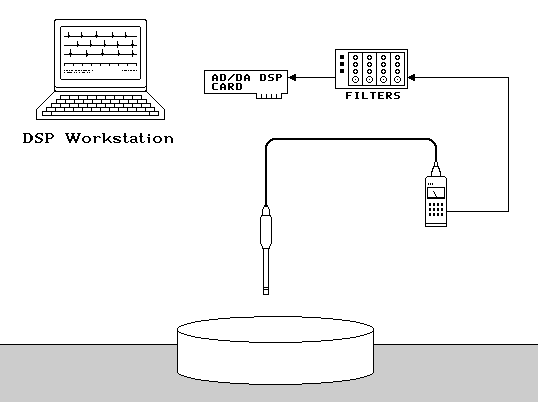
Lepidoptera, moths
Research on moth courtship behaviour has focused primarily on female pheromones and male behavioural responses to them. Several studies have demonstrated that the complete sequence of courtship behaviour also involves male pheromones and other types of communication, including sound production.
Our research concerns sound production in three species of the family Pyralidae tipically infesting stored products: Ephestia cautella (Walker), Ephestia kuehniella Zeller, Plodia interpunctella (Hübner) .
Sounds produced by these moths consist of regular sequences of ultrasonic pulses with a frequency range up to 80 kHz, emitted by wing-fanning males during courtship behaviour. In these species the male's sound producing organ occurs in front of the tegulae, rounded plates that cover the forewing insertions: a pulse is emitted at each wing beat. The pulses are emitted in regular sequences at intervals of 14-24 ms, corresponding to pulse-repetition rates of 41-72 pulses per second. Ultrasonic communication in these moths plays a significant role in mating behaviour. Thus courtship behaviour has been reconsidered with greater emphasis on the interaction between multiple communicative modalities.

The spectrogram shows the sequence of ultrasonic pulses produced by a wing-fanning male of Plodia interpunctella. Frequency range 0-90 kHz, time span 427 ms, tic-marks 21.33 ms, analysis bandwidth 1 kHz.
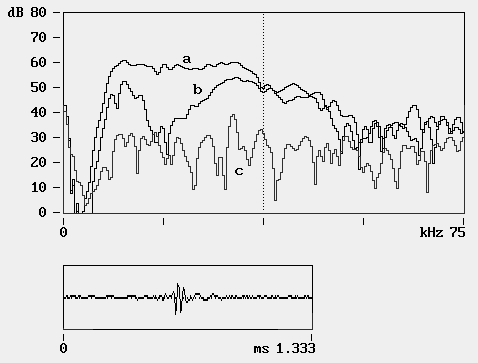
Spectra of two pulses (a,b) compared to the spectrum of noise (c) in digital recordings of Plodia interpunctella (the amplitude scale in dB is relative to an arbitrary reference). The lower graph shows the waveform of the pulse b.
Formicidae, ants
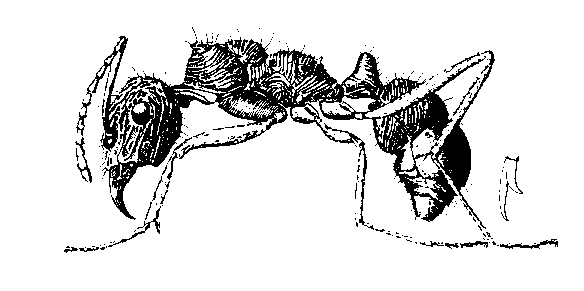
Even if stridulation in ants is a known behaviour, the effective communicative role of sound and ultrasound production is still uncertain. Our research, developed in collaboration with the Laboratory of Ethology of the University of Tolouse (France) and the Department of Biology of the University "La Sapienza" of Rome (Italy), concerns the acoustic emission in neotropical ants.
Specimen of five species of neotropical ants, Ectatomma permagnum Forel, Ectatomma quadridens Fabr., Ectatomma ruidum Roger, Ectatomma tuberculatum Oliver, Pachycondyla apicalis Latreille were tested in the laboratory to verify their ability to produce ultrasounds. The signals recorded from the genus Ectatomma appeared homogeneous in their acoustic structure: they were typically emitted in long sequences and were made of pulse-trains extending in frequency up to 75 kHz and consisted in two subunits (dysillabic chirps) characterized by pulses with opposite phase. Chirps are produced by the alternate movement of a simple plectrum against a pars stridens.
On the contrary, in Pachycondyla sounds were monosyllabic chirps, consisting in a single train of pulses.

Spectrogram and envelope of signals emitted by Ectatomma quadridens. The chirps are clearly dysillabic.
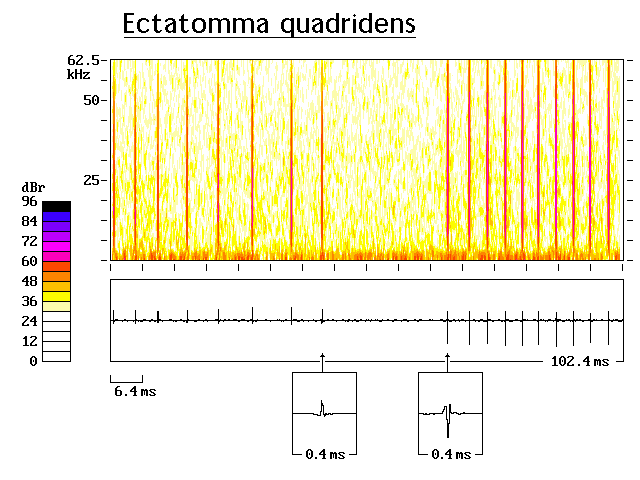
Spectrogram, envelope and detailed waveforms of pulse trains emitted by Ectatomma quadridens: the opposite phase characterizes the two sub-units of the disyllabic chirp.

Spectrogram and envelope of signals emitted by Pachycondyla apicalis. The structure of chirps is clearly monosyllabic.
Coleoptera

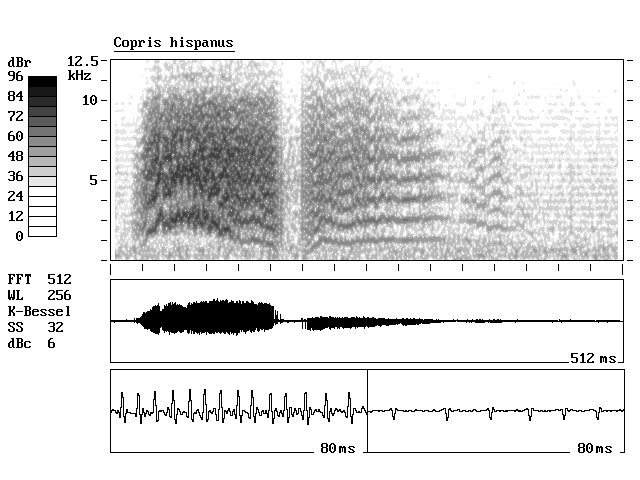
Spectrogram, envelope and detailed waveforms of pulse trains emitted by Copris uncertus and Copris hispanus (Coleoptera Scarabaeidae: Coprinae): the two sub-units of the disyllabic chirps are characterized by pulses with opposite phase. Research made in cooperation with the Zoology Dept. of the University of Torino (1989).
References
PALESTRINI C., PAVAN G., ZUNINO M., 1990. Acoustic signals and stridulatory apparatus in Copris incertus Say (Coleoptera Scarabaeidae: Coprinae). Acta Zool. Mex., Messico, (ns), 39: 1-18.
PAVAN G., PALESTRINI C., TREVISAN E., 1990. Contribution to the knowledge of Thorectes intermedius (Costa) (Coleoptera: Scarabaeoidea: Geotrupidae) larval stridulation. Elytron, Spagna, 4: 153-159.
PALESTRINI C., PAVAN G., ZUNINO M., 1991. Acoustic signals in Copris incertus Say (Coleoptera Scarabaeidae Coprinae). Ethology, Ecology & Evolution, Special Issue 1: 143-146.
Trematerra P., Pavan G., 1994. Role of ultrasound production and chemical signals in the courtship behaviour of Ephestia cautella (Walker), Ephestia kuehniella Zeller and Plodia interpunctella (Hübner) (Lepidoptera:Pyralidae). Proc. 6th Inter. Work. Conf. on Stored-product Protection, 1, Camberra: 591-594.
Trematerra P., Pavan G., Priano M., Serra B., 1994. Interazioni tra differenti canali di comunicazione nel corteggiamento di Cadra cautella (Walker), Ephestia kuehniella Zeller e Plodia interpunctella (Hübner). Atti XVII Congresso nazionale italiano di Entomologia, Udine 13-18 giugno 1994: 309-314.
Trematerra P., Pavan G., 1995. Ultrasound Production in the Courtship Behaviour of Ephestia cautella (Walk.), E.kuehniella Z. and Plodia interpunctella (Hb.) (Lepidoptera: Pyralidae). J. stored Prod. Res., 31 (1): 43-48.
PAVAN G., DE CARLI P., PRIANO M., LACHAUD J.P., BEUGNON G., FANFANI A., GIOVANNOTTI M., 1996. Stridulation in 5 species of Neotropical Ponerinae ants (Hymenoptera, Formicidae). Ins. Soc. Life, 1: 169-172.
LEIS M., PAVAN G., SBRENNA G., 1996. Intercastal communication in Reticulitermes lucifugus (Isoptera, Rhinotermitidae). Ins. Soc. Life, 1: 49-53.
DE CARLI P., PAVAN G., PRIANO M., LACHAUD J.P., FANFANI A., GIOVANNOTTI M., 1996. Analyse comparative des stridulations émises par 4 espèces de fourmis ponérines (Hymenoptera, Formicidae). Actes Coll. Insectes Sociaux, 10: 125-131.
PAVAN G., PRIANO M., DE CARLI P., LACHAUD J.-P., FANFANI A., GIOVANNOTTI M., 1997. Stridulatory organ and ultrasonic emission in certain species of Ponerine ants (Genus Ectatomma and Pachycondyla, Hymenoptera, Formicidae). Bioacoustics, 8 (3&4): 209-221.
MORI A., GRASSO D.A., LE MOLI F., GIOVANNOTTI M., PAVAN G., PRIANO M., 1998. Morphological and bioacoustical evidence for lack of sound production by queens of Polyergus rufescens during host colony usurpation (Hymenoptera, Formicidae). Fragmenta Entomologica, vol. XXX: 191-200.
GRASSO D., PRIANO M., PAVAN G., MORI A., LE MOLI F., 2000. Stridulation in four species of Messor ants (Hymenoptera, Formicidae). Ital. J. Zool., 67: 281-285.
Latest works:
Polidori C., Ruffato G., Borruso L., Settanni C., Pavan G., 2012. Stridulatory organ and distress call in males and females of a small velvet ant (Hymenoptera: Mutillidae). Bioacoustics. DOI:10.1080/09524622.2012.736241
Polidori C., Pavan G., Ruffato G., D’Asís J., Josè Tormos J., 2013. Common features and species-specific differences in stridulatory organ and stridulation patterns of velvet ants (Hymenoptera: Mutillidae).
Home Page of the Centro Interdisciplinare di Bioacustica e Ricerche Ambientali